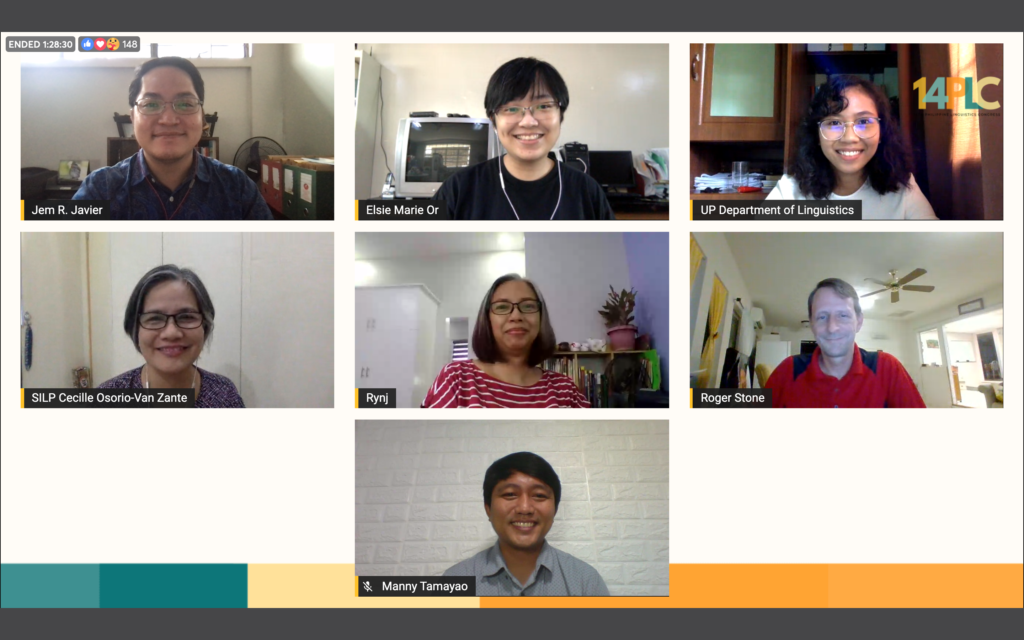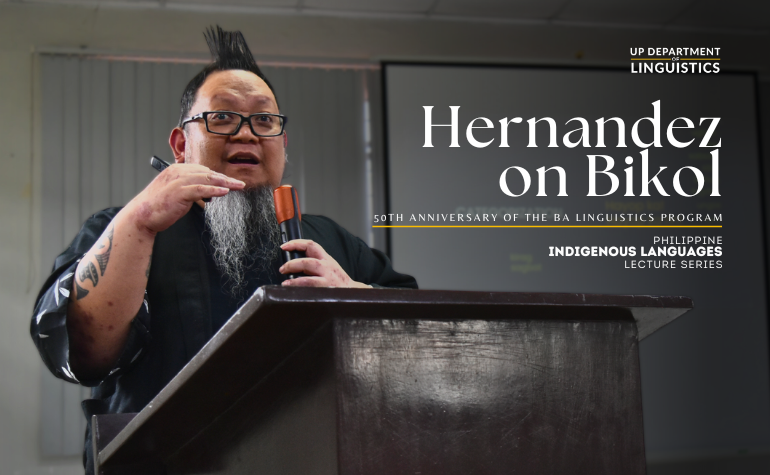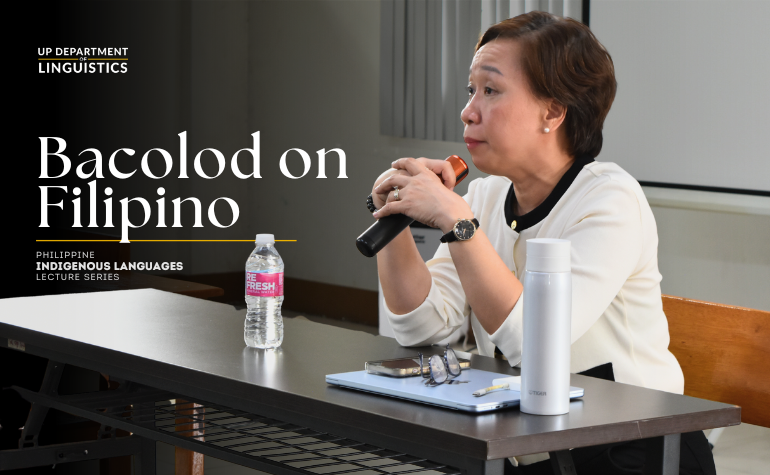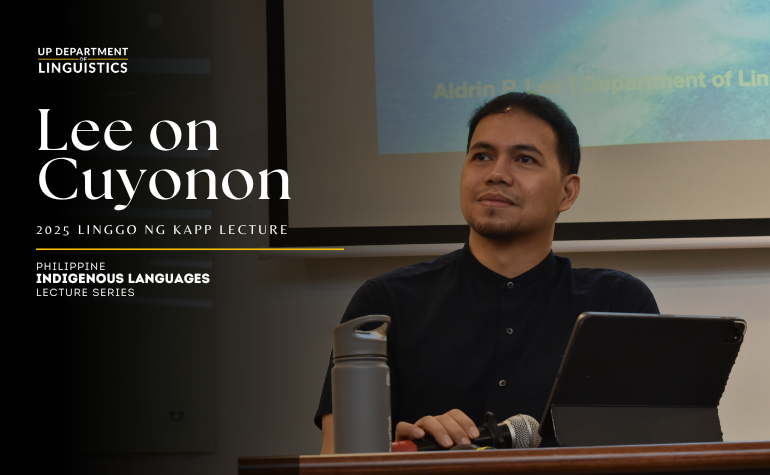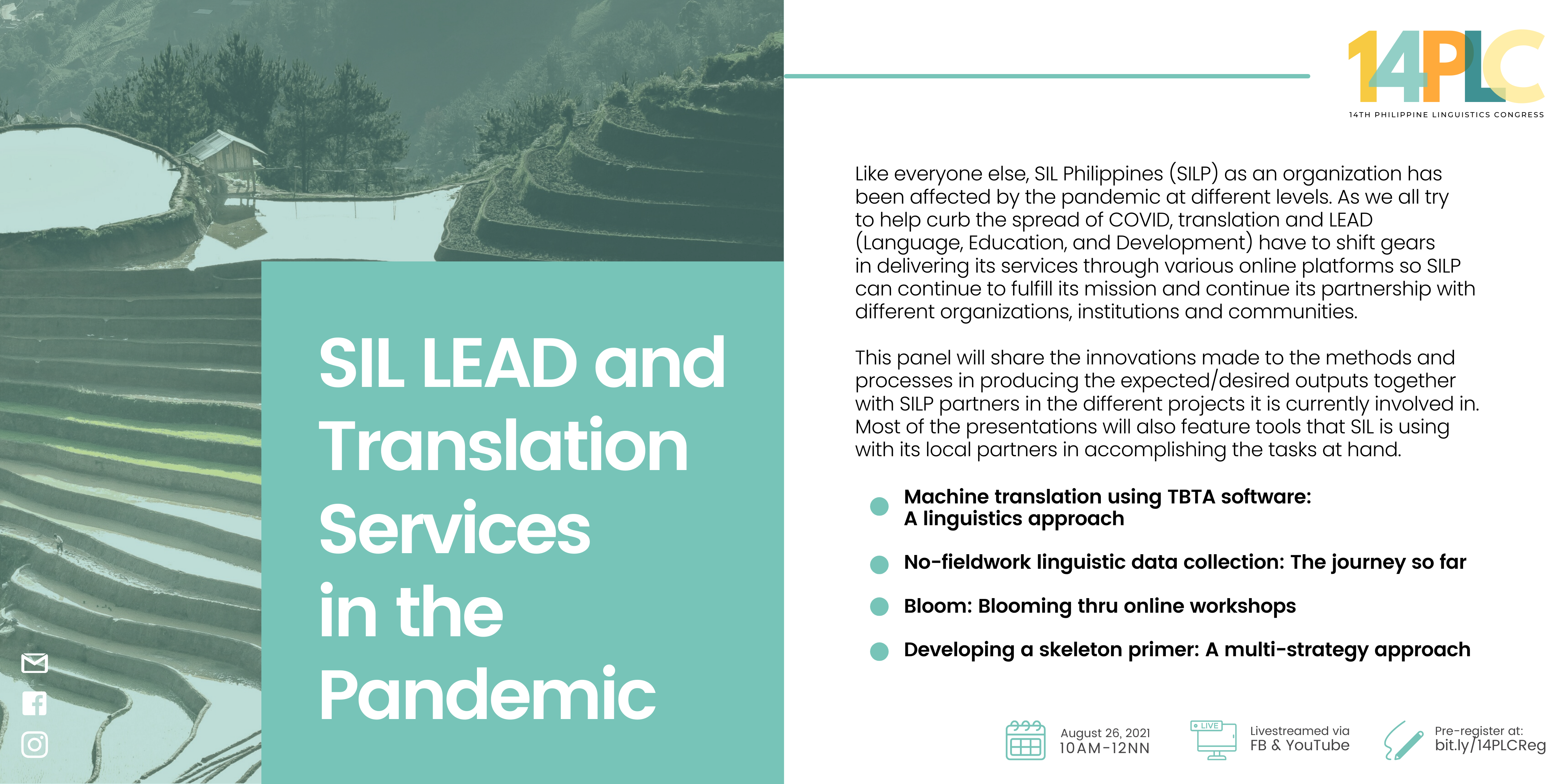
The fourth panel during the 14th Philippine Linguistics Congress highlighted the significance of the services offered by the Summer Institute of Linguistics Philippines (SILP), a volunteer and nonprofit organization that supports translation, research, training, and materials development catering to the various Philippine language groups since 1953. The event was held on 26 August 2021, with the following speakers all from SILP: Roger Stone, one of the SIL linguists; Manuel Tamayao, library and archives manager; Maria Cecilia Osorio-Van Zante, literacy and education consultant; and Rynj Gonzales, language assessment consultant-in-training who also moderated the panel.
SILP LEAD
SILP LEAD (Language, Education, and Development), the SILP team responsible for helping communities and their partners, uses technology to simplify language development activities in a bid to enhance education through improving the efficiency of early-grade reading programs. Due to the different quarantine restrictions brought by the pandemic, they had to shift gears and move all the procedures into various online platforms to continuously pursue their mission and retain their partnerships with different organizations, language communities, and institutions.
The panel discussed the innovative methods and processes currently applied by the organization together with their partners to achieve the expected outputs from the projects they are currently involved in. The presentations featured state-of-the-art online tools the organization is using at present.
The Primer
Van Zante shed light on how SILP LEAD conducts online workshops for developing supplementary materials using a free app. It requires the participants to have a corpus and orthography of the target language as well as picturable words. The speaker discussed the differences between the top-down and bottom-up approaches as well as the skeleton primer being a simplified multi-strategy approach in teaching reading to learners.
PrimerPrep App is a free SIL software where the corpus will be encoded. This will reveal the most productive words in the language. The primer process involves identifying keywords, sentence creation, generating a word list, and key picture selection. Sight words are selected. These are the words that are most commonly used and they are integrated into the supplementary materials. This process is repeated until all the sounds, letters, symbols, and words are represented in the lessons. A chart is used for developing the primer lesson plan which is the expected output of the workshop. As a way of assessing the accuracy of the lesson plan produced, Grade 1 students must be able to identify the keywords included. This is why online illustration testing is part of the process. A skeleton primer would take around 2 to 3 weeks to complete.
Bloom
SILP also use and conduct training for Bloom. According to Tamayao, Bloom is a multi-awarded free computer program for creating books easily. It has no computer literacy or training requirement. He further said that the program will allow more people to write books in their local languages. This cutting-edge yet user-friendly software can fill the vacuum created by a limited corpus in many minority languages.
This will help fill the need for local materials in the local languages. “Bloom makes it easy to create simple books, translate, and contextualize them into multiple languages,” Tamayao said. This state-of-the-art software enables writers who have limited computer skills to create books in their mother tongues. With its multiple templates from a basic book to a sign language book, writers will be able to create a book with a simple layout and formatting features.
Training for language material development using Bloom has also shifted to online platforms. Google Classroom is primarily used and the entire training contains nine basic lessons. Each lesson consists of links, videos, manuals, and screenshots. Instructional videos were created and uploaded to YouTube while Messenger and WhatsApp are used for simultaneous collaboration between the trainer and the trainees. The output of the training will be submitted as a screenshot or an uploaded file, which can be sent through email or any of the messaging apps.
No-Fieldwork Data Collection
Gonzales shared her experience on Itneg Illaud data collection. Itneg Illaud is spoken in the communities of Ilocos Sur, Ilocos Norte, and Abra. It has been declared a threatened language and apart from a basic grammar sketch, there are no other grammar descriptions in the language.
Gonzales delved into how she shifted gears from the traditional data gathering methods which require attending cultural and communication events and personally eliciting data using elicitation lists. She suggested the use of Facebook chat and video calls for the pre-elicitation stage. Informed consent is done by the participant sending a video recording of oneself which is sent through Facebook chat or email. Video recording is also made possible using a mobile phone. All the collected data were transported to several tools for linguistic analysis such as Saymore and Flex. She also mentioned the challenges involved in recording data which include connectivity problems, particularly when using social media platforms and video conferencing apps.
Gonzales opined that remote data collection is easier when the researcher has the right contacts and enjoys a good relationship with the community. She figured that it is significant to draft a research plan with the community ahead of time, know your goals and limitations by heart, and adjust your recording protocols if necessary. She added that even when remote data elicitation is possible, she still looks forward to visiting the Itneg Illaud community soon.
TBTA
Roger Stone has been documenting the grammar and working on the lexicography of Ayta and Sambal languages. He has been collaborating with the Ayta Mag-Indi bible translation committee for the New Testament translation.
The project, which was launched on 9 June 2021, aims to translate 7,954 verses of the New Testament. The process of translation involves the mother-tongue speakers drafting each verse from scratch and working together as they go through the checking procedures to ensure accuracy and naturalness before the output is sent to the Philippine Bible Society for printing.
Stone thoroughly discussed the machine translation method used mainly for bible translation: The Bible Translators Assistant (TBTA). Its principles are based on Rule Based Machine Translation (RBMT). RBMT contains linguistic information about the source and target languages gathered from dictionaries and grammars. This information covers semantic, morphological, lexicon, and syntactic regularities of the language.
Stone and his team started using the TBTA during the quarantine period. The tool has major components: Semantic Representative, Ontology, Transfer Grammar, and Synthesizing Grammar. The first step is for a semantic analyzer to tag the text from the source language or the original language. “Each noun is tagged for number, person, plurality, gender, common versus proper,” Stone explained. Another component of the TBTA is Ontology which is a collection of approximately 2,000 semantically simple English concepts. These include those recommended by natural semantic metalanguage theorists and some that are listed in the Longman’s Dictionary. The third component is Transfer Grammar which produces a new underlying “deep structure” representation of the sentence. This is also the component where several Philippine language features can be incorporated in the translation process such as voice or focus. The fourth component is Synthesizing Grammar which is responsible for the synthesis and organization of the actual “surface level” sentence in the target language or the language the original language is translated to. The draft is checked by mother tongue speakers, tested in the community for comprehension, and sent to a consultant for final approval.
Stone said that the entire process is conducted online and that includes communication with the partners and the community. He deems the process as pandemic proof and has other applications other than bible translation. TBTA can be used for the creation of school textbooks, how-to manuals, health information, short stories, and others. Currently, there are only three languages encoded in the system: Tagalog, Ayta Mag-Indi, and Eastern Subanen. The software shows a lot of promise in not only empowering the mother tongue speakers but most particularly in increasing the speed and efficiency of translation. TBTA can be used in translating any material into any target language.
Open Forum
Various points of the presentations caught the attention of the audience, but what spawned the most number of queries was on Bible translation through TBTA. One of the questions from the audience dealt with preserving the integrity of the Bible when doing translation, to which Stone reiterated the different checks that the translation has to go through before it is approved. He explained the entire process followed by his translation team which involves both automated means through TBTA and traditional means by way of manually checking the translation and forwarding it to the next person in authority who will do the further assessment until the translation is deemed worth submitting to the Philippine Bible Society. Asked about the language of the primary text used for Bible translation, he said that the translations are done based on the original Hebrew or Greek version instead of Tagalog or English. He added that when they do manual translation, they do get several ideas from the Tagalog and English versions of the Bible.
Another question was about the capacity of the TBTA tool to translate complex sentences. Stone responded that it can be done although it is more difficult. As for concepts or terms that do not have equivalents in the target language, he replied that there are several strategies to use depending on the translation style. The term can be provided an alternative cultural representation or compared to something more familiar to the speakers of the target language. It may be given a lengthy explanation to ensure the clarity of the concept. For the translation of figurative language used in poetry, proverbs, etc. he does not recommend using TBTA for those types of constructions. He further added that there is no one-size-fits-all solution but that despite some disadvantages, machine translation also has many advantages, placing emphasis on the empowering capacity of the tool for writers in the target language who may not have the means to produce a translation on their own.
Other questions focused on conducting fieldwork, e.g. difficulties of data collection, interviews, recording, the ethical considerations of handling the collated data, including the amount of money and time required for accomplishing the fieldwork. Gonzales replied that it helps to find a foster family in the community and that normally you allot your budget for travel and personal expenses. Asked about whether she used a language consultant or researcher for her data analysis considering that she does not speak the language she is documenting, she emphasized the importance of familiarity with the language. She added that her previous interactions with the community and her preliminary research helped her to narrow the gap caused by a language barrier.
All in all, the SILP panel has shown that language documentation, translation, and language development activities can still be done even with an ongoing pandemic, through the use of various innovative programs and tools.
The recording of the SIL panel presentations can be viewed on our YouTube channel.
Published by Ava A. Villareal

